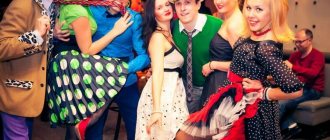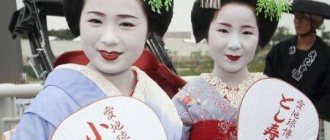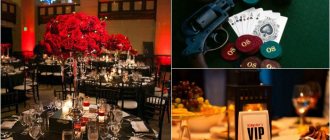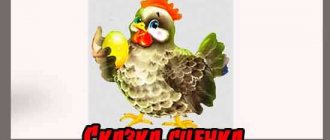1936-1940 A festive tandem was formed - Father Frost and Snow Maiden and Christmas tree markets appeared
Since December 1936, the celebration of the New Year has acquired an all-Union scope.
the Izvestia newspaper described in its issue dated December 31, 1938 : “At dusk, the first guests of the New Year’s tree came here. Everyone has a badge on their chest with the inscription “Happy New Year, we wish you to be an excellent student.” A huge Christmas tree shines with thousands of colorful lights in the Hall of Columns. Her rightful owner, Santa Claus, came and the celebration began. The guys sang, danced, and recited. After spinning around the Christmas tree, the kids rode on the carousel, and the older boys practiced shooting with an electric revolver. It was all fun, joyful, festive.”
"New Year's Tree Celebration" Newspaper "Moscow Bolshevik" dated December 29, 1945
At the end of the 1930s. Mass production of Christmas tree decorations also began, many of which, in the spirit of the times, were made in the form of airships, airplanes, and machine tools. But the main decoration of the tree was a red five-pointed star. And it was at this time that Father Frost himself first came out to those celebrating with his companion, Snegurochka.
For the first few years after the first Christmas tree, the capital’s authorities practically did not regulate the festive elements in any way. However, the population cut down Christmas trees in such large numbers that this caused concern in the Moscow City Council about the fate of the capital’s forest protection belt. Starting in 1939, this situation began to change, and the city authorities began to strictly monitor the supply of Christmas trees to Moscow and their sale. Private trade in Christmas trees was strictly prohibited in order to reduce the number of illegal logging.
At the New Year's tree in the Hall of Columns during the opening of the holiday. Authors: A. Batanov, V. Mastyukov. Moscow, December 29, 1952
How we celebrated the New Year in the USSR
The unique feeling of a fairy tale with the aromas of pies, tangerines and pine needles, “Blue Light” in the dead of night, cheerful trips with grandparents to the Kremlin Christmas tree, and, of course, a mega-gift from Santa Claus - all this was in my happy childhood. Let's remember?
More important than your birthday
I, like every child in the USSR, realized that the New Year is the most important holiday of the year, even more important than a birthday, May 1 and 9 or November 7. Therefore, we began to prepare for it long ago. It was necessary to learn poems about the New Year, come up with and prepare “skits”, decorate the house (especially the windows) with homemade garlands and snowflakes (as many scissors - so many options!), decide who to be at the matinee - a Snowflake or a Sorceress, write greeting cards to all relatives, get sparklers and firecrackers from Soyuzpechat, make crafts for your relatives with your own hands. The hassle is overwhelming.
At the same time, parents went through another entertaining quest - “Get everything for the New Year!” Often we, the children, were involved in this. After all, there were not enough coveted green peas, famous Baltic sprats and mayonnaise for Olivier in the USSR for everyone. This shortage was “thrown away” in stores on the eve of the holiday, and Soviet people had to move from one line to another. This is where the child came to the rescue, who could be put “holding his place” and rush to the new deficit. But all of us - both pioneers and pensioners - were persistent: after all, the New Year's table had to be abundant and generous.
What a delight this jellied fish of yours is! Probably, the New Year of the USSR era is clearly etched in the memory also because it was on this holiday that one could try something that was rarely available in everyday life. Finnish cervelat, canned pineapples and crabs, red (sometimes black) caviar, lemon slices in tin boxes - all this has been stocked almost since the summer. And everyone, even the most spoiled child, knew that some jars could not be taken out of the refrigerator - they were “for the New Year.” But on the holiday, the eyes widened with abundance. What is characteristic is that in those years no one had even heard of any special children's table - even the little ones devoured everything fried, floury, spicy, salted and peppered along with the adults. And no allergies or other undesirable consequences. Mystery of the era.
A special word about oranges and tangerines. They didn’t immediately pounce on them - first they admired the fragrant miracle, sometimes they hung them on the Christmas tree as decorations, and then they didn’t throw away the peels - they dried them. After all, it continued to smell like New Year, and, by the way, was popular as a natural fragrance in linen closets and as a moth repellent. Citrus fruits were brought to the Union for the New Year from Morocco, Egypt and Israel, but in scanty quantities; Even in Moscow you had to stand in a hefty queue for them. Throughout the winter, tangerine oranges could be bought at the market from lively Abkhazians, but they were expensive.
Today we remembered the New Year's fun.
Our family, like other Soviet families, celebrated the holiday at home - in a large or VERY large company. Close relatives, family friends, parents’ work colleagues would certainly be at the table, and, like a rose on a cake, beloved neighbors, whom you didn’t have to specifically invite, they came on their own. It was unforgettable for the children. After all, everything revolved around us: guests certainly brought small gifts to the child, applauded songs about Santa Claus, and participated in skits that were performed in front of the Christmas tree.
And most importantly, you could legally NOT SLEEP that night! You were allowed not to go to bed until the chiming clock, to hear the congratulations of dear Leonid Ilyich, and to watch “The Blue Light” - as long as you could sit through it. By the way, the postman Pechkin did not bend his heart: the TV was indeed the best decoration of the New Year's table, and the programs pleasantly amazed the inexperienced Soviet viewer. Quite late at night, at about 2-3 o'clock, one could see something completely extraordinary - a concert of foreign stars! But we children, of course, did not survive until such a time - the regime was taking its toll, from which not a single Soviet child could escape. But on the morning of January 1, our time had come: cartoons, children's films and performances were broadcast on all two channels. Therefore, while the adults were sleeping, we had something to occupy ourselves with.
Another highlight of the first of January is finding a gift under the tree. By the way, despite the 70s fashion for artificial Christmas trees, my parents stubbornly continued to bring real Christmas trees from the market. They were installed in a bucket of sand, and they could easily stand like that without crumbling for a couple of months. One of the trees survived until the May holidays, fluffed up and took root - I had to give it to friends for planting at their dacha. Another mystery of Soviet reality.
Parents did not take one child from the Kremlin Christmas tree and...
My parents had no choice but to go back to work on January 2, but we had a long holiday coming up. There was a lot of fun: filling snow forts in the yard with a street cleaner's hose, and sliding down steep slides in the park without adult supervision, and jumping from garages into a snowdrift, and snowballs almost on the roadway. Any modern parent would have a heart attack seeing this. But we were invulnerable, cheerful and cheerful, like goldfinches.
And the most important event, of course, was going to the New Year's Eve party. Usually, tickets for it were distributed by trade union committees at work for adults - either for free or for a nominal fee. Not only were children treated to an interesting performance, but they were also given a “sweet” gift - in the form of chests, books or a five-pointed star. These boxes are still stored on my mezzanine.
I was lucky - for a couple of years in a row I was in the St. George Hall of the Grand Kremlin Palace, at the most important Christmas tree in the country. They said that there were not only the best shows, but also the best food packages. But we, the children, of course, did not think about this, as well as about the status of this event: we were more interested in the huge crowd of schoolchildren from the entire Union, sometimes in the most exotic national costumes. But the circle around which the children were led after the performance, and the parents who nervously snatched their children from the crowd, was a little tense. As it turned out later, I was not the only one: this ritual served as a rich occasion for folk myth-making. Much later, I read a horror story about how a boy was lost on Cathedral Square in the Kremlin and... But these, of course, are just urban legends - not a single child was lost after the Kremlin Christmas tree.
How did you celebrate your New Year in the USSR? What funny and touching customs do you remember?
Good luck to you, New Year, good sales and fun holidays!
1967-1971 Cash and clothing lotteries and New Year's lights from the Mossovet on the streets of the capital
Since 1967, the New Year's cash and clothing lottery has been held annually. According to the order of the Executive Committee of the Moscow Council No. 28/24, the ticket price was set at 30 kopecks. In addition to the sum of money, one could win various household goods from blankets and carpets to a car or motorcycle. The total cost of all tickets was about 30 million rubles, and the total winnings were 18 million.
Dance of the “Snow Beauties” at the children’s New Year’s Eve party in the Column Hall of the House of Unions. Photo by V. Kuzmin and V. Khristoforov. Moscow, December 28, 1973
In addition to entertainment, streets and squares began to be decorated in the capital, creating the atmosphere of a New Year's fairy tale. Thus, since 1969, the Executive Committee of the Moscow City Council, by its orders, allocated funds for the purchase and installation of Christmas trees in squares, as well as for their decoration. And since 1971, they began to actively decorate individual squares, streets and avenues.
Without separation from the team
The tradition of organizing performances for children - New Year trees - arose in the 1930s. At the same time, it was impossible to simply go and buy a ticket for them.
“From schools and kindergartens, through departments of public education, through trade unions, a certain quota was allocated for Christmas trees of a higher level - in the House of Unions, in the Kremlin. These tickets were given to the best of the best. It was a dream. Work collectives had their own quotas. The remaining tickets were distributed between districts on a territorial basis, among excellent students. Of course, there has always been a percentage of those who took advantage of their official position. But there were few of them,” says Mikhail Morukov.
The adults also celebrated the New Year collectively. Initially, this holiday was not considered a purely family holiday, as is customary now. Often, Soviet citizens celebrated the New Year in the company of colleagues, especially if December 31st fell on a working day. Many enterprises had their own clubs, canteens, and cultural centers where celebrations were held. Balls were organized several times for the elite in the Kremlin.
Large catering enterprises, restaurant trusts and canteens were also preparing for the New Year. Unlike catering establishments at enterprises, anyone could come to city and station restaurants. There were no restrictions.
On the Lenin Hills, mass skating was organized on specially pre-filled ice slides. So the New Year could be celebrated in the fresh air.
Decor
All this gastronomic abundance was placed on a folding table-book, which was available in, perhaps, all Soviet families. They took out “holiday dishes” - the same services that had been waiting for the holiday all year in the wall-mounted slide.
The central art object of the apartment was the Christmas tree, usually a live one.
Artificial ones, including silver ones, rarely appeared. Both real and artificial New Year's trees looked a little bald, so they were richly decorated. Cardboard boxes were taken out from the mezzanines, where multi-colored tinsel, rain, and glass (namely glass!) Christmas tree decorations were stored. Sometimes children made paper garlands-chains and snowflakes, flat and three-dimensional. “Snow” made of cotton wool was placed on the branches of the tree, and a red star or golden pot-bellied spiers were placed on the top of the head. And under the Christmas tree they placed the Snow Maiden and Santa Claus made of plastic or papier-mâché.
Already sitting at the table, they lit sparklers and launched streamers over their heads. Firecrackers were in short supply, and for a long time fireworks could only be seen on TV.
Things from the USSR that we miss terribly.
Gifts for everyone
The city was decorated for the holiday, street fairs and Christmas tree markets were organized. All stores were required to throw out sets of New Year's gifts on the shelves. In some years, city authorities even allocated several hundred passenger taxis and trucks to deliver congratulations and gifts.
Recording studios invited everyone to record congratulations and send the records to friends. The radio held congratulatory hours during which you could convey your New Year's greetings and wishes to your friends. A special ritual was sending New Year's cards .
“It was a good tradition to send a card to relatives, colleagues, school friends or even pen pals. Expressing wishes in a beautiful and creative form has become a kind of hobby. Many people collected these congratulations. Postcards with written text, where you just need to add your signature, are a sign of the 1990s. Before this, postcards were very different, and writing something from yourself, finding words from the heart was considered good manners,” says Mikhail Morukov.
A sweet gift was an indispensable attribute of any Christmas tree. And at home, children were usually given candy, toys, construction sets, young chemist kits, and something for studying. Adults often received accessories, perfume, gloves, scarves, and handkerchiefs as gifts. Sometimes they gave something more significant, like a watch.
Another way to receive gifts was the cash and clothing lottery, which began to gain popularity in the 1960s. Muscovites actively participated in it.
New Year cards in retro style (vintage)
We go further into the depths of time. This section contains a small collection of New Year and Christmas cards in retro style. In pre-revolutionary times, the Christmas holiday was a priority and main thing, so cards were mainly made on this topic. And of course, vintage images reflected that modernity and everyday life. People born later can appreciate the beauty of such stories and understand the values and spirit of that time.
Tangerines and champagne
One of the main symbols of the New Year are tangerines . Citrus fruits were a popular gift in the USSR. Other fruits in the country were unavailable in winter.
“Initially, citrus fruits were delivered only to children's institutions, and they did not even go on sale. Abkhazian tangerines were a gift from the warm republics to Moscow and a means of stimulating their production. In the 1950–1960s, the culture of tangerine breeding in Abkhazia was already developed. The harvest was taken just in late autumn, from mid-November. Moscow has traditionally had good economic ties with the Caucasus regions. In winter, flowers were also brought to the capital from the Caucasus. Muscovites decorated their apartments with fresh, fresh flowers for the New Year,” says Mikhail Morukov.
Another traditional table decoration is salads, especially Olivier . They were considered a sign of hospitality and hospitality. They had a lot of ingredients, which, however, did not break the family budget. Hazel grouse from traditional recipes was replaced with sausage, capers with carrots and green peas.
“The Olivier salad has pre-revolutionary, even bourgeois origins. It appeared in Moscow in the 19th century. Salads began to enter the everyday life of Soviet housewives in 1939, when the first edition of the “Book on Tasty and Healthy Food” was published. But with meat and vegetables, which are required for the salads described in the book, the situation in the capital returned to normal only in the mid-1950s. It was during this period that herring under a fur coat, Olivier salad and Mimosa salad entered our everyday life,” says Mikhail Morukov.
On New Year's Day, Muscovites loved to eat ice cream. Also on the festive table there is always champagne . The production of the Soviet sparkling drink began in the south of the USSR before the war. After 1945, the Moscow Champagne Wine Factory began operating in the capital, and the ringing of glasses to the sound of the chimes soon became an invariable attribute of the holiday.
“Originally, champagne was the drink of the nobility. Sparkling wine was a sign of a broad, beautiful, prosperous life. But the big city was quickly changing the way of thinking of the population. After all, Moscow has always been a city of visitors. Already at the beginning of the 20th century, native Muscovites, those whose grandparents lived in Moscow, numbered less than 10 percent. The new population, joining the city culture, gradually created its own traditions. Champagne became one of those. The proletarian could now afford what the princes used to drink. Champagne has become a sign of raising life to a new level,” says Mikhail Morukov.
No frills or ideology
January 1st became a holiday shortly after the Great Patriotic War. However, the New Year holidays were only for children. From January 2, everyone returned to work.
It was not customary to celebrate the holiday for several days. On New Year's Eve, public transport worked longer than usual, usually up to two hours. By this time, the vast majority of Muscovites had completed the celebration, returned home, put gifts for the children under the tree and went to bed.
The situation changed with the ubiquity of television. Muscovites began to go to bed later and stay at home more often.
New Year in our country does not have ancient traditions. Nevertheless, in a relatively short period of time in historical terms, it was able to become a beloved and truly popular holiday.
“New Year is a holiday that you arrange yourself and wish for what you want. On this day, a Soviet person could show his emotions not by order. This is a holiday from the heart, from the heart. This is why the New Year is so popular,” concludes Mikhail Morukov.










